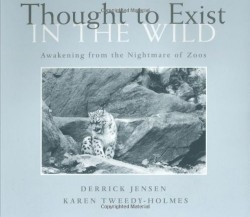
Thought to Exist in the Wild
Awakening from the Nightmare of Zoos
Inferior, mindless, unthinking, intemperate, sensualist: Jensen presents these synonyms for “animal” as evidence of the arrogant mindset of man, that enables zoos to continue to incarcerate wild animals for human pleasure. This book is an impassioned argument for the dissolution of zoos and a return to a lifestyle that enables man to live in equal relationship to his animal, plant, and inanimate neighbors in nature.
Jensen is an environmental writer and activist with ten books to his name, including A Language Older than Words and The Culture of Make Believe. Here he offers a text written in a conversational tone that engages the reader while tackling a subject encompassing psychological, social, and environmental issues. At intervals throughout the book are three portfolios of emotional black and white photos by Tweedy-Holmes, who has been published in magazines including National Geographic. In one, a giraffe strains fruitlessly upward to reach the branches of a tree not already stripped clean of leaves, the metal roofing of zoo buildings in the background.
Jensen presents his ideas in the form of an intelligent, well-organized debate, starting with the history of zoos, moving on to their faults, and finally addressing the flaws in arguments for zoos. Zoo proponents state that animals live longer in zoos than in the wild, but this claim is based on the longest life span, not the average. In reality, one-fifth to one-quarter of all zoo animals die each year, and three quarters of apes die within two years of captivity.
Many zoos boast of captive breeding programs, claiming that zoos are the last chance for survival of endangered species. To this Jensen replies, “Natural selection is turned on its head, as zoos select for those who are able to survive not in their habitat but in captivity…” For example, interrupting migration for just one generation can cause birds to return too early and face adverse conditions.
Unfortunately, some of Jensen’s more damning claims are based on sources more than thirty years old. In one instance, he quotes a lengthy passage about a grisly elephant hunt by a zoo provider that took place at the beginning of the twentieth century. It would make for a more compelling argument to seek out recent examples of unethical zoo acquisitions or abuses to present to the reader.
In all, Jensen writes with a conviction that leads readers, whether or not they agree with him, to think deeply about what their own beliefs are about zoos. This book would be a valuable addition to zoology courses in high schools and universities, as it would introduce a voice not often heard in these classes and provide a spark for serious debate and thought, not only about the content of the text, but about what students may see in the eyes of a mountain gorilla or the posture of a black bear in Tweedy-Holmes’s photographs.
“For now,” Jensen writes. “… a giraffe still stands in a cell too small for her ever again to break into a run.”
Reviewed by
Christine Canfield
Disclosure: This article is not an endorsement, but a review. The publisher of this book provided free copies of the book to have their book reviewed by a professional reviewer. No fee was paid by the publisher for this review. Foreword Reviews only recommends books that we love. Foreword Magazine, Inc. is disclosing this in accordance with the Federal Trade Commission’s 16 CFR, Part 255.
